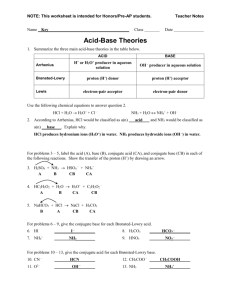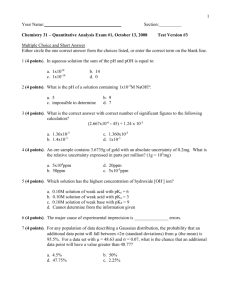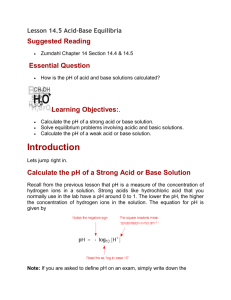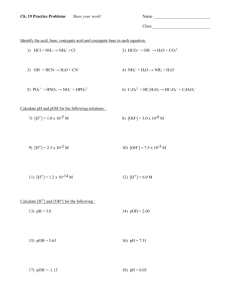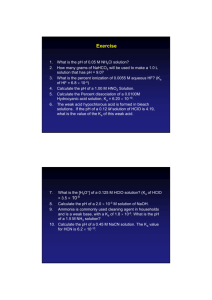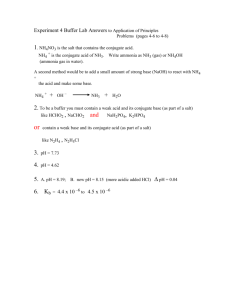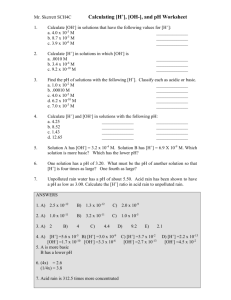Chapter 14
advertisement
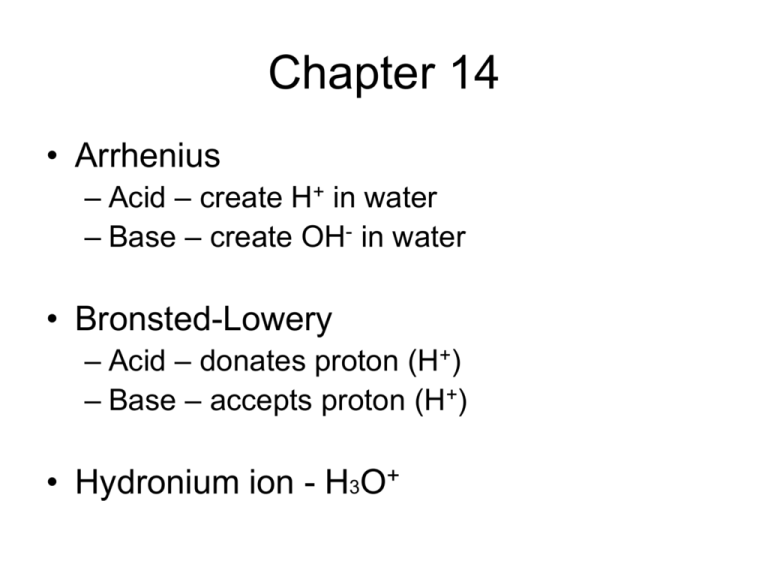
Chapter 14 • Arrhenius – Acid – create H+ in water – Base – create OH- in water • Bronsted-Lowery – Acid – donates proton (H+) – Base – accepts proton (H+) • Hydronium ion - H3O+ • Conjugate pairs – HCN/CN- HCl/Cl- NH3/NH4+ • Acid dissociation constant – Equilibrium expression for its dissociation – Ka – HF H+ + F– Ka = [H+][F-] / [HF] • Strong vs weak • Oxyacids – HNO3, HClO4, H2SO4 • Organic Acids – COOH group HC2H3O2 (CH3COOH) • Monoprotic, diprotic, triprotic – HCl, H2SO4, H3PO4 • Water as an acid and base – H2O + H2O H3O+ + OH- • Amphoteric • Dissociation constant for water – Kw = [H3O+][OH-] = 1.0 x 10-14 – [OH-] = 1.0 x 10-5 [H3O+] = ? – [H3O+] = 1.0 x 10-14 / 1.0 x 10-5 = 1.0 x 10-9 • pH – pH = - log[H+] • pOH – pOH = - log[OH-] • pH + pOH = 14 • Calculate the pH and pOH of a 1.0 x10-9M HCl solution. – pH = - log(1.0x10-9) = 9.0 pOH = 14 – 9 = 5.0 – What is the [H+] if the pH = 4.4 – pH = -log[H+] [H+] = 10-pH – [H+] = 10-4.4 = 3.98 x 10-5 = 4.0 x 10-5M • pH of strong acids – Completely dissociates so [acid] = [H+] • pH of weak acids – Have to do an equilibrium problem using Ka – Follow the same process – HF H+ + F– Ka = [H+][F-] / [HF] = 7.2 x 10-4 – Calculate the pH of a 1.0 M HF solution – Chem. – [H+] – [F-] – [HF] Initial 0 0 1.0 Equil. +x +x 1.0 – x = 1.0 (small x) – Ka = [H+][F-] / [HF] = 7.2 x 10-4 – 7.2 x 10-4 = x2 / 1.0 x = 2.7 x 10-2 M – pH = -log(2.7 x 10-2) = 1.57 • pH of a mixture of acids – Focus on the strongest acid – Our HF example also contained H2O but we can ignore it since its constant is 1.0 x 10-14 and HF is much larger, 7.2 x 10-4 • Percent dissociation – %diss. = [H+] / [HA]o x 100 • What is the pH of an aqueous solution of 1.00M HCN and 5.00M HNO2. – HCN Ka = 6.2 x 10-10 – HNO2 Ka = 4.0 x 10-4 – H2O Kw = 1.0 x 10-14 – Strongest acid is HNO2 so we use it • HNO2 Ka = 4.0 x 10-4 – HNO2 H+ + NO2- • • • • Chem. HNO2 H+ NO2- [init.] 5.00 0 0 [equil] 5.00-x = 5.00 +x +x – 4.0 x 10-4 = x2 / 5.00 – x = 4.5 x 10-2 – pH = -log(4.5 x 10-2) = 1.35 (x is small) • Bases – We calculate [OH-] just like [H+] but use Kb instead of Ka • pH of strong bases – Completely dissociates so the [Base] = #[OH-] • pH of weak bases – Focus on the strongest base present and do an equilibrium problem • Calculate the [OH-] for a 15.0 M NH3 solution, Kb = 1.8 x 10-5. – NH3 + H2O NH4+ + OH– Kb = [NH4+][OH-] / [NH3] = 1.8 x 10-5 – Chem. – NH4+ – OH– NH3 [Init.] 0 0 15.0 [Equil] +x +x 15.0 – x = 15.0 – Chem. – NH4+ – OH– NH3 [Init.] 0 0 15.0 [Equil] +x +x 15.0 – x = 15.0 – Kb = [NH4+][OH-] / [NH3] = 1.8 x 10-5 – 1.8 x 10-5 = x2 / 15.0 – x = 1.6 x 10-2 – pOH = -log(1.6 x 10-2) = 1.80 – pH = 14 – 1.80 = 12.20 • Strong bases make weak adics • Strong acids make weak bases • So the larger the Ka the smaller the Kb • Ka x Kb = Kw • Polyprotic acids – Dissociate one proton at a time – Follow the same steps as an equil. problem – Calculate the pH as well as the concentration of all other chemicals present in a 5.0M H3PO4 aqueous solution. – H3PO4 Ka1 = 7.5 x 10-3 – H2PO4- Ka2 = 6.2 x 10-8 – HPO42- Ka3 = 4.8 x 10-13 • H3PO4 H+ + H2PO4• Ka1 = 7.5 x 10-3 = [H+][H2PO4-] / [H3PO4] – Chem. – H+ – H2PO4– H3PO4 [init] 0 0 5.0 [equil] +x +x 5.0 – x = 5.0 – 7.5 x 10-3 = x2 / 5.0 – x = 0.19 = [H+] = [H2PO4-] • H2PO4- H+ + HPO42• Ka2 = 6.2 x10-8 = [H+][HPO42-]/[H2PO4-] – Chem – H+ – HPO42– H2PO4- [init] 0.19 0 0.19 [equil] 0.19+x = 0.19 +x 0.19 – x = 0.19 – 6.2 x10-8 = (0.19)x / 0.19 x = 6.2 x10-8 – [HPO42-] = 6.2 x 10-8 • HPO42- H+ + PO43• Ka3 = 4.8 x 10-13 = [H+][PO43-]/[HPO42-] – Chem – H+ – PO43– HPO42- [init.] 0.19 0 6.2 x 10-8 [equil.] 0.19 + x = 0.19 +x 6.2 x10-8 -x = 6.2x10-8 – 4.8 x 10-13 = (0.19)x / 6.2 x 10-8 – x = 1.6x10-19 – [PO43-] = 1.6 x 10-19 • [OH-] – Kw = 1.0 x 10-14 = [H+][OH-] – 1.0 x 10-14 = (0.19)[OH-] – [OH-] = 5.3 x 10-14 • Sulfuric acid – Similar to phosphoric acid except the first dissociation is complete and we can use that info for the second dissociation problem. – Calculate the [SO42-] in a 1.0M aqueous H2SO4 solution. – H2SO4 H+ + HSO4– [H2SO4] = [H+] = [HSO4-] = 1.0 • HSO4- H+ + SO42• Ka2 = 1.2 x 10-2 = [H+][SO42-] / [HSO4-] – Chem. – H+ – SO42– HSO4- [init.] 1.0 0 1.0 – 1.2 x 10-2 = (1.0)x / 1.0 – [SO42-] = 1.2 x 10-2 M [equil.] 1.0 + x = 1.0 +x 1.0 – x = 1.0 x = 1.2 x 10-2 • Acid/Base properties of salts – Salts from strong acids/bases produce neutral solution, NaCl, KNO3 etc – Salts from weak acid, strong base produce basic solutions, NaF, KC2H3O2 – F- + H20 HF + OH– Salts from strong acid, weak base produce acidic solutions, NH4Cl – NH4+ + H2O NH3 + H3O+ – Highly charged metal ions like Al3+ produce acidic solutions when hydrated, because of the large charge it is easier to release H+ • Ka x Kb = Kw • So if you know a chemicals Ka or Kb you can determine the corresponding Ka / Kb as needed • Calculate the pH for a 0.1 M NH4Cl aqueous solution. Kb = 1.8 x 10-5 for NH3 • NH4+ reacts with water like an acid so we need it’s Ka. We get it from the Kb – – – – Ka = Kw / Kb = 1.0 x 10-14 / 1.8 x 10-5 = 5.6 x 10-10 NH4+ + H2O NH3 + H3O+ Chem [init.] [equil.] NH4+ 0.1 0.1 – x = 0.1 – NH3 – H3O+ 0 0 +x +x – Ka = 5.6 x 10-10 = [NH3][H3O+] / [NH4+] – 5.6 x 10-10 = x2 / 0.1 – x = 7.5 x 10-6 = [H3O+] – pH = -log (7.5 x 10-6) = 5.13 • Structure effect HClO vs HClO4 – The extra oxygens draw the electrons away from the hydrogen allowing it to be released more easily. Thus HClO4 is stronger – How do HNO2 and HNO3 compare? • Acid/Base properties of oxides – Non-metal oxides produce acids when mixed with water – SO3 + H2O H2SO4 – CO2 + H2O H2CO3 – Metal oxides produce bases when mixed with water – CaO + H2O Ca(OH)2 – Na2O + H2O NaOH • Lewis Acid/Bases – Acids accept electron pairs – Bases donate electron pairs – BH3 + NH3 BH3NH3 – BH3 is the acid – NH3 is the base

